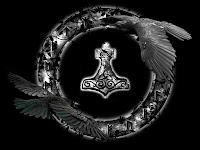Adolf Hitler
The Holy Grail is a dish, plate, stone, or cup that is part of an important theme of Arthurian literature.
There is good reason for believing that the Grail was originally a Pagan talisman; but, assuming that origin, it developed in course of time into a purely Christian symbol, and the legend was then largely influenced by Christian ideas.
The legends of the Holy Grail are woven of three strands: a Celtic tradition of other-world vessels and supernaturally powerful weapons; an Arabic or Byzantine tradition of a mysterious stone that had fallen from the heavens; and a Christian tradition, perhaps of Gnostic or heretical origin, of a mysterious talisman.
 |
| Robert Burnes - The Holy Grail |
Chretien's story attracted many translators and interpreters in the later 12th and early 13th centuries, including Wolfram von Eschenbach.
Later the Grail legend became interwoven with legends of the Holy Chalice.
The connection with Joseph of Arimathea and with vessels associated with the 'Last Supper' and crucifixion of Jesus, dates from Robert de Boron's Joseph d'Arimathie (late 12th century) in which Joseph receives the Grail from an apparition of Jesus and sends it with his followers to Great Britain.
Building upon this theme, later writers recounted how Joseph used the Grail to catch Christ's blood while interring him.
The legend may combine Christian lore with a Celtic myth of a cauldron endowed with special powers.
____________________________________________
 |
| Frederick Judd Waugh - The Holy Grail |
 |
| A Greek Two-Handed Cup |
Alternate suggestions include a derivative of 'cratis', a name for a type of woven basket that came to refer to a dish, or a derivative of Latin 'gradus' meaning "'by degree', 'by stages', applied to a dish brought to the table in different stages or services during a meal".
 |
| George Frederick Watts Galahad |
Hélinand of Froidmont described a grail as a "wide and deep saucer" (scutella lata et aliquantulum profunda).
Other authors had their own ideas: Robert de Boron portrayed it as the vessel of the Last Supper.
The authors of the 'Vulgate Cycle' used the Grail as a symbol of divine grace.
Galahad, illegitimate son of Lancelot and Elaine, the world's greatest knight and the Grail Bearer at the castle of Corbenic, is destined to achieve the Grail, his spiritual purity making him a greater warrior than even his illustrious father.
Galahad, and the interpretation of the Grail involving him were picked up in the 15th century by Sir Thomas Malory in 'Le Morte d'Arthur', and remain popular today.
Chrétien de Troyes
The Grail is first featured in 'Perceval, (Parsifal) le Conte du Graal' (The Story of the Grail) by Chrétien de Troyes, who claims he was working from a source book given to him by his patron, Count Philip of Flanders.
In this incomplete poem, dated sometime between 1180 and 1191, the object has not yet acquired the implications of holiness it would have in later works.
In this incomplete poem, dated sometime between 1180 and 1191, the object has not yet acquired the implications of holiness it would have in later works.
While dining in the magical abode of the 'Fisher King', Perceval witnesses a wondrous procession in which youths carry magnificent objects from one chamber to another, passing before him at each course of the meal.
First comes a young man carrying a bleeding lance, then two boys carrying candelabras.
Finally, a beautiful young girl emerges bearing an elaborately decorated graal, or "grail."
Finally, a beautiful young girl emerges bearing an elaborately decorated graal, or "grail."
For Chrétien a grail was a wide, somewhat deep dish or bowl.
Perceval, who had been warned against talking too much, remains silent through all of this, and wakes up the next morning alone.
He later learns that if he had asked the appropriate questions about what he saw, he would have healed his maimed host, much to his honour.
Chrétien de Troyes was a French poet and trouvère who flourished in the late 12th century.
Chrétien may have named himself Christian of Troyes in contrast to the Rashi, also of Troyes.
Little is known of his life, but he seems to have been from Troyes, or at least intimately connected with it, and between 1160 and 1172 he served at the court of his patroness Marie of France, Countess of Champagne, daughter of Eleanor of Aquitaine, perhaps as herald-at-arms (as Gaston Paris speculated).
His work on Arthurian subjects represents some of the best regarded of medieval literature.
His use of structure, particular in Yvain, the Knight of the Lion, has been seen as a step towards the modern novel.
Chrétien de Troyes was a French poet and trouvère who flourished in the late 12th century.
Chrétien may have named himself Christian of Troyes in contrast to the Rashi, also of Troyes.
Little is known of his life, but he seems to have been from Troyes, or at least intimately connected with it, and between 1160 and 1172 he served at the court of his patroness Marie of France, Countess of Champagne, daughter of Eleanor of Aquitaine, perhaps as herald-at-arms (as Gaston Paris speculated).
His work on Arthurian subjects represents some of the best regarded of medieval literature.
His use of structure, particular in Yvain, the Knight of the Lion, has been seen as a step towards the modern novel.
Robert de Boron
Though Chrétien’s account is the earliest and most influential of all Grail texts, it was in the work of Robert de Boron that the Grail truly became the "Holy Grail" and assumed the form most familiar to modern readers. In his verse romance Joseph d’Arimathie, composed between 1191 and 1202, Robert tells the story of Joseph of Arimathea acquiring the chalice of the Last Supper to collect Christ’s blood upon his removal from the cross.
Joseph is thrown in prison, where Christ visits him and explains the mysteries of the blessed cup.
Upon his release Joseph gathers his in-laws and other followers and travels to the west, and founds a dynasty of Grail keepers that eventually includes Perceval (Parsifal).
Upon his release Joseph gathers his in-laws and other followers and travels to the west, and founds a dynasty of Grail keepers that eventually includes Perceval (Parsifal).
Other Early Literature
After this point, Grail literature divides into two classes.
The first concerns King Arthur’s knights visiting the Grail castle or questing after the object;
the second concerns the Grail’s history in the time of Joseph of Arimathea.
The nine most important works from the first group are:
The Perceval of Chrétien de Troyes.
Four continuations of Chrétien’s poem, by authors of differing vision and talent, designed to bring the story to a close.
 |
| Wolfram von Eschenbach |
The Didot Perceval, named after the manuscript’s former owner, and purportedly a prosification of Robert de Boron’s sequel to Joseph d’Arimathie.
The Welsh romance Peredur, generally included in the Mabinogion, likely at least indirectly founded on Chrétien's poem but including very striking differences from it, preserving as it does elements of pre-Christian traditions such as the Celtic cult of the head.
Perlesvaus, called the "least canonical" Grail romance because of its very different character.
The German Diu Crône (The Crown), in which Gawain, rather than Perceval, achieves the Grail.
The Lancelot section of the vast Vulgate Cycle, which introduces the new Grail hero, Galahad.
The Queste del Saint Graal, another part of the Vulgate Cycle, concerning the adventures of Galahad and his achievement of the Grail.
Of the second class there are:
Robert de Boron’s Joseph d’Arimathie,
The Estoire del Saint Graal, the first part of the Vulgate Cycle (but written after Lancelot and the Queste), based on Robert’s tale but expanding it greatly with many new details.
Verses by Rigaut de Barbezieux, a late 12th or early 13th century Provençal troubador, where mention is made of Perceval, the lance, and the Grail ("Like Perceval when he lived, who stood amazed in contemplation, so that he was quite unable to ask what purpose the lance and grail served" - "Attressi con Persavaus el temps que vivia, que s'esbait d'esgarder tant qu'anc non saup demandar de que servia la lansa ni-l grazaus").
Though all these works have their roots in Chrétien, several contain pieces of tradition not found in Chrétien which are possibly derived from earlier sources.
Belief in the Grail and interest in its potential whereabouts has never ceased.
Ownership has been attributed to various groups (including the Knights Templar, probably because they were at the peak of their influence around the time that Grail stories started circulating in the 12th and 13th centuries)
 |
| Saint Mary of Valencia Cathedral |
 |
| Glastonbury Tor. |
It was the official papal chalice for many popes, and has been used by many others, most recently by Pope Benedict XVI, on July 9, 2006.
 The emerald chalice at Genoa, which was obtained during the Crusades at Caesarea Maritima at great cost, has been less championed as the Holy Grail since an accident on the road, while it was being returned from Paris after the fall of Napoleon, revealed that the emerald was green glass.
The emerald chalice at Genoa, which was obtained during the Crusades at Caesarea Maritima at great cost, has been less championed as the Holy Grail since an accident on the road, while it was being returned from Paris after the fall of Napoleon, revealed that the emerald was green glass. |
| Rosslyn Chapel |
In Wolfram von Eschenbach's telling, the Grail was kept safe at the Castle of Munsalvaesche (Mons Salvationis), entrusted to Titurel, the first Grail King.
Some, not least the Benedictine monks of Montserrat, have identified the castle with the real sanctuary of Montserrat in Catalonia, Spain.
Other stories claim that the Grail is buried beneath Rosslyn Chapel, or lies deep in the spring at Glastonbury Tor.
 |
| Dante Gabriel Rossetti The Damsel of the Sanct Grail |
 |
| 'Idylls of the King' - Death of Arthur |
The high seriousness of the subject was also epitomized in Dante Gabriel Rossetti's painting, in which a woman modeled by Jane Morris holds the Grail with one hand, while adopting a gesture of blessing with the other.
A major mural series depicting the Quest for the Holy Grail was done by the artist Edwin Austin Abbey during the first decade of the 20th century for the Boston Public Library.
Other artists, including George Frederic Watts and William Dyce also portrayed grail subjects.
Other artists, including George Frederic Watts and William Dyce also portrayed grail subjects.
_____________________________________________________________
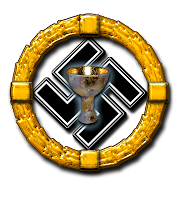

© Copyright Peter Crawford 2012
RICHARD WAGNER - THE GRAIL and HITLER
It is this interpretation which is accepted by Ravenscroft in 'The Cup of Destiny' (1981) and Angebert in 'The Occult and the Third Reich' (1974).

The stone from Lucifer's crown can therefore be regarded as ego-consciousness or "I am !".
Without the 'awakening mind principle' humanity would not be able to acquire knowledge, and the first step along this path is "I am I."
The combination of hushed reverence, chromatic harmonies and sexualized imagery in Richard Wagner's late opera Parsifal gave new significance to the grail theme.
Every German schoolboy knew the great folk tale of the Grail by heart.
 |
| Wolfram von Eschenbach's 'Parzival' |
Every German schoolboy knew the great folk tale of the Grail by heart.
Wolfram von Eschenbach's 'Parzival' was one of the greatest works of literature in the German (or any other) language.
On the surface it is a familiar tale of a pure knight's search for perfect love and redemption.
Few pieces of heroic literature had more impact on the nation-conscious Germans than Parzival.
The Grail legend can interpreted in two ways:
Generally, it is viewed as a story of Christian love and the redemption of mankind.
The second is the mythical interpretation.
The Grail is said to contain a coded message known only to a few, and understood by a tiny number.
 |
| The Cup of Destiny |
Lucifer was a Prince of Heaven before his sin prompted God to cast him to Hell.
On the descent to the Underworld his crown fell to earth, and from it a huge emerald.
This was used by men of antiquity to fashion a drinking cup to be used in occult rituals.
Here we find the most ancient relic accepted by both Christians and Gnostics.
The cup was ringed with the usual special signs, symbols, runes and the like, all depicting the ascent of man through various stages to a final state of blessedness.
The Grail had become the sacred vessel of Initiate Knowledge.
It contained on its exterior the great trove of primordial knowledge and tradition which linked the past to the future.
That primordial knowledge can bring man back into the natural and only true condition for him, the primordial state of consciousness.
Within Germany many regarded the Grail as the lost, secret book of the Aryan race.
It had been entrusted to them since eons past, and was lost and recovered on occasion.
What precisely it contained was unknown, and since it was written in symbols, the interpretation given these runes may have differed from age to age.
It was the one great treasure of all Aryans, at all times.
From age to age it had been the uniting factor, the one artifact that provided a rationale for the existence of the race.
The Grail predated Christianity.
This is an absolute whose acceptance is necessary for understanding the importance of it as an artefact to the NSDAP and its leaders.
In Alfred Rosenberg's 'Myth of the 20th Century' the 'Grail' may be viewed as the cause of German objection to some aspects of Christianity, notably to Roman Catholicism.
It may be viewed as having provided direction to the German people, or at least a significant portion of it, when the people were confronted by orthodox Western church teachings which were alien to them.

The Grail, the cup which Jesus used at the Last Supper, was made from the stone which fell from Lucifer's crown as he plunged to earth (see left).
Lucifer (the Light-bringer) brought the mental principle to evolving humanity.
 |
| © Copyright Peter Crawford 2012 |
Without the 'awakening mind principle' humanity would not be able to acquire knowledge, and the first step along this path is "I am I."
That this stone was fashioned into a cup or bowl which was used to catch the blood of 'god' elevates its meaning because it then stands for the divine self.
As Wagner remarked, it becomes "Grail consciousness" - purified, redeemed "I am."
| © Copyright Peter Crawford 2012 |
The Grail is entrusted to Titurel.
He gathers a brotherhood of knights around him, called the 'Knights of the Grail', who devote themselves to the service of this 'Grail consciousness' through heroic deeds.
A second important symbol is the 'spear', derived from the spear of Longinus (see left) who, it is said, thrust it into Christ's side during the crucifixion, shedding the Redeemer's blood.
It stands for 'higher mind', that part of us which must decide whether the mind will aspire to spirit or succumb to material desire.
 |
| Parsifal and the Flower Maidens |
His claim to have invented the interpretation of the Grail as a 'chalice' is disingenuous, as he must have known about Christian interpretations of the Grail, even before he read 'Perceval'.
There is evidence that Wagner had read Chrétien de Troyes and the 'Continuations' in the edition by Ch. Potvin, published in seven volumes between 1866 and 1871, of which there are copies in his Wahnfried library.
The first of Potvin's volumes contains a work that has no direct connection with Chrétien: the 'Perlesvaus', a prose romance that scholars believe was written in northern France, a few years after the death of Chrétien and perhaps as late as 1225.
Richard Wagner was familiar with the work of contemporary scholars on the sources of Wolfram's epic but dismissed his interpretation of the Grail as a stone brought to earth by angels.
 |
| The Temptation of Parsifal -1894 - Arthur Hacker |
 Wagner adopted a 'Christianised' version of the Grail, but discarded the Question entirely, made the recovery of the spear the focus of the story, and changed some of the names from those found in Wolfram's poem.
Wagner adopted a 'Christianised' version of the Grail, but discarded the Question entirely, made the recovery of the spear the focus of the story, and changed some of the names from those found in Wolfram's poem.
He introduced many other elements, however: such as the 'election' of those who might find their way to the Grail, the life-preserving power of the Grail, and the descending dove.
Intelligent guesses can be made about Wagner's familiarity with the writings of Chrétien de Troyes, Robert de Boron and others, at first probably through secondary sources, such as German authors of the early 19th century, including the commentary on Parzival by San-Marte.
Wagner first conceived the work in April 1857, but it was not finished until twenty-five years later.
It was to be Wagner's last completed opera and, in composing it, he took advantage of the particular and remarkable acoustics of the Bayreuth Festspielhaus.
'Parsifal' was first produced at the second Bayreuth Festival in 1882.
Wagner preferred to describe 'Parsifal' not as an opera, but as "ein Bühnenweihfestspiel" - "A Festival Play for the Consecration of the Stage".
According to his own account, recorded in his autobiography 'Mein Leben' (My Life), Wagner conceived 'Parsifal' on Good Friday morning, April 1857, in the Asyl ("Asylum"), the small cottage on Otto Wesendonck's estate in the Zürich suburb of Enge, which Wesendonck - a wealthy silk merchant and generous patron of the arts - had placed at Wagner’s disposal, through the good offices of his wife Mathilde Wesendonck.
'Parsifal' was to be Wagner's last and greatest completed opera.
In 'Parsifal' Wagner uses a distinctive motive to represent the Grail, which is based on the sublime 'Dresden Amen''
The 'Dresden Amen' was composed by J.G. Naumann (1741-1801) for use in the 'Königliche Kapelle in Dresden' - (royal chapel at Dresden) and elsewhere in Saxony.
Richard Wagner became familiar with this music during his years there as Kapellmeister, between 1842 and 1849.
No doubt he had heard it earlier, both in Leipzig and in Dresden.
It is one of the few themes that appears in the prelude to the first act, and throughout the music-drama this motive appears more often than any other.
The great philosopher Frederick Nietzsche heard the Parsifal Vorspiel for the first time in Monte-Carlo in January 1887 :
'Putting aside all irrelevant questions (to what end such music can or should serve?), and speaking from a purely aesthetic point of view, has Wagner ever written anything better?
The supreme psychological perception and precision as regards what can be said, expressed, communicated here, the extreme of concision and directness of form, every nuance of feeling conveyed epigrammatically; a clarity of musical description that reminds us of a shield of consummate workmanship; and finally an extraordinary sublimity of feeling, something experienced in the very depths of music, that does Wagner the highest honour; a synthesis of conditions which to many people - even "higher minds" - will seem incompatible, of strict coherence, of "loftiness" in the most startling sense of the word, of a cognisance and a penetration of vision that cuts through the soul as with a knife, of sympathy with what is seen and shown forth. Has anyone ever depicted so sorrowful a look of love as Wagner does in the final accents of his Prelude ?'
'I cannot think of it without feeling violently shaken, so elevated was I by it, so deeply moved.
It was as if someone were speaking to me again, after many years, about the problems that disturb me.
When listening to this music one lays Protestantism aside as a misunderstanding - and also, I will not deny it, other really good music, which I have at other times heard and loved, seems, as against this, a misunderstanding !'
Wagner first conceived the work in April 1857, but it was not finished until twenty-five years later.
It was to be Wagner's last completed opera and, in composing it, he took advantage of the particular and remarkable acoustics of the Bayreuth Festspielhaus.
'Parsifal' was first produced at the second Bayreuth Festival in 1882.
Wagner preferred to describe 'Parsifal' not as an opera, but as "ein Bühnenweihfestspiel" - "A Festival Play for the Consecration of the Stage".
 |
| Bayreuth Festspielhaus |
In 'Parsifal' Wagner uses a distinctive motive to represent the Grail, which is based on the sublime 'Dresden Amen''
 |
| Wagner - Grail Leitmotiv © Copyright Peter Crawford 2012 |
Richard Wagner became familiar with this music during his years there as Kapellmeister, between 1842 and 1849.
No doubt he had heard it earlier, both in Leipzig and in Dresden.
It is one of the few themes that appears in the prelude to the first act, and throughout the music-drama this motive appears more often than any other.
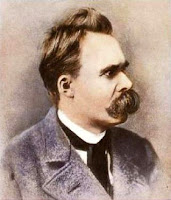 |
| Frederick Nietzsche |
 |
| Peter Gast |
The supreme psychological perception and precision as regards what can be said, expressed, communicated here, the extreme of concision and directness of form, every nuance of feeling conveyed epigrammatically; a clarity of musical description that reminds us of a shield of consummate workmanship; and finally an extraordinary sublimity of feeling, something experienced in the very depths of music, that does Wagner the highest honour; a synthesis of conditions which to many people - even "higher minds" - will seem incompatible, of strict coherence, of "loftiness" in the most startling sense of the word, of a cognisance and a penetration of vision that cuts through the soul as with a knife, of sympathy with what is seen and shown forth. Has anyone ever depicted so sorrowful a look of love as Wagner does in the final accents of his Prelude ?'
Letter to Peter Gast - 1887
 |
| Elizabeth Forster Nietzsche |
'I cannot think of it without feeling violently shaken, so elevated was I by it, so deeply moved.
It was as if someone were speaking to me again, after many years, about the problems that disturb me.
When listening to this music one lays Protestantism aside as a misunderstanding - and also, I will not deny it, other really good music, which I have at other times heard and loved, seems, as against this, a misunderstanding !'
Letter to Elizabeth Forster Nietzsche (Nietszche's sister) - 1887
Hitler, a great admirer of Frederick Nietzsche, saw in Wagner's 'Parsifal' a detailed parable of "a religious brotherhood of Templars to guard the Holy Grail, the august vessel containing the pure blood".
 |
| Adolf Hitler |
 |
| Parsifal |
The Grail, defined here as the "vessel", refers to the 'racially pure body' which holds the blood that can absorb divine-knowledge.
In search of this holy blood, which contains the coveted 'knowledge', every member of the SS was screened for purity of Aryan lineage, and was taught his duty to father as many racially pure children as possible.
For Hitler the 'gnostic' themes of the Grail and the cosmic struggle between Light and Darkness were perfectly portrayed in Richard Wagner's 'Parsifal'.
Being an occult initiate, Hitler was aware of the Gnostic message behind "the externals of the story, with its Christian embroidery... the real message was pure, noble blood, in whose protection and glorification the brotherhood of the initiated have come together."
Hitler continued -
One can serve God only in the garb of the hero.
What is celebrated in Wagner's 'Parsifal' is not the Christian religion of compassion, but pure and noble blood, - blood whose purity the brotherhood of initiates has come together to guard.
The king (Amfortas) then suffers an incurable sickness, caused by his tainted blood.
Then the unknowing but pure human being (Parsifal) is led into temptation, either to submit to the frenzy and to the delights of a corrupt civilisation in Klingsor's magic garden, or to join the select band of knights who guard the secret of life, which is pure blood itself.
All of us suffer the sickness of miscegenated, corrupted blood.
Note how the compassion that leads to knowledge applies only to the man who is inwardly corrupt, to the man of contradictions.
And 'Eternal Life', as vouchsafed by the Grail, is only granted to those who are truly pure and noble !
Only a new nobility can bring about the new culture.
If we discount everything to do with poetry, it is clear that elitism and renewal exist only in the continuing strain of a lasting struggle.
A divisive process is taking place in terms of world history.
The man who sees the meaning of life in conflict will gradually mount the stairs of a new aristocracy.
He who desires the dependent joys of peace and order will sink back down to the unhistorical mass, no matter what his provenance.
But the mass is prey to decay and self-disintegration.
At this turning- point in the world's revolution the mass is the sum of declining culture and its moribund representatives.
They should be left to die, together with all kings like Amfortas.'
Careful consideration of Hitler's statement about Wagner's 'Parsifal' tells us something very significant.
Whereas Heinrich Himmler thought of the Grail as an actual object - probably a chalice or a cup, and sent Otto Wilhelm Rahn on numerous pointless journeys to find the said object, Hitler saw its true occult and symbolic nature.
In addition, Hitler realised that Wagner had made the essential connection between the Grail and the Spear.
The spear is an important element in Wagner's version of the Grail story, and this is where Wagner deviates from the earlier accounts of the Grail mystery.
While Hitler suspected that the Spear of Longinus (St Maurice Speer), held in the Schatzkammer in Wien, was the spear used during the crucifixion of Jesus - symbolically he associated it with the spear in Wagner's 'Parsifal'.
For Wagner, the 'union' of the Spear and the Chalice of the Grail were essential to the eventual consummation of the drama.
Through his involvement with the 'Thule Gesellschaft' (which derived some of its traditions from the OTO), Hitler understood the sexual symbolism of Wagner's sacred drama.
Ordo Templi Orientis (O.T.O.) (Order of the Temple of the East) is an international fraternal and religious organization founded at the beginning of the 20th century.
Originally it was intended to be modelled after, and associated with Freemasonry, but it was later reorganized around the Law of Thelema as its central religious principle.
This Law - expressed as “Do what thou wilt shall be the whole of the Law" and "Love is the law, love under will” - was promulgated in 1904 with the writing of 'The Book of the Law'.
The Grail Cup - the Holy Grail - symbolises the purity and perfection of the 'Aryan womb',and the Spear symbolises the Aryan phallus.
The bringing together of these two elements represents the sexually creative union, which is essential to the creation of the 'pure, noble blood', which was in turn necessary for the creation of the Übermensch.
Careful consideration of Hitler's statement about Wagner's 'Parsifal' tells us something very significant.
Whereas Heinrich Himmler thought of the Grail as an actual object - probably a chalice or a cup, and sent Otto Wilhelm Rahn on numerous pointless journeys to find the said object, Hitler saw its true occult and symbolic nature.
 |
| The Spear and the Chalice © Copyright Peter Crawford 2012 |
The spear is an important element in Wagner's version of the Grail story, and this is where Wagner deviates from the earlier accounts of the Grail mystery.
While Hitler suspected that the Spear of Longinus (St Maurice Speer), held in the Schatzkammer in Wien, was the spear used during the crucifixion of Jesus - symbolically he associated it with the spear in Wagner's 'Parsifal'.
 |
| © Copyright Peter Crawford 2012 |
Through his involvement with the 'Thule Gesellschaft' (which derived some of its traditions from the OTO), Hitler understood the sexual symbolism of Wagner's sacred drama.
Ordo Templi Orientis (O.T.O.) (Order of the Temple of the East) is an international fraternal and religious organization founded at the beginning of the 20th century.
Originally it was intended to be modelled after, and associated with Freemasonry, but it was later reorganized around the Law of Thelema as its central religious principle.
This Law - expressed as “Do what thou wilt shall be the whole of the Law" and "Love is the law, love under will” - was promulgated in 1904 with the writing of 'The Book of the Law'.
The Grail Cup - the Holy Grail - symbolises the purity and perfection of the 'Aryan womb',and the Spear symbolises the Aryan phallus.
The bringing together of these two elements represents the sexually creative union, which is essential to the creation of the 'pure, noble blood', which was in turn necessary for the creation of the Übermensch.
The creation of the Übermensch would allow Hitler to achieve an 'unprecedented exaltation of the human race'.
Perhaps Hitler's most perceptive and significant, yet little known statement was that the purpose of human evolution was 'to achieve a mystic vision of the Universe'.
And Hitler knew that this vision - this union with the ultimate - could only be achieved by the race of 'demi-gods and god-men' - and it was this that motivated all the concern about the purity of the Aryan race that formed and essential part of Völkisch philosophy - because only the Aryan 'god-man' could achieve the ultimate purpose of creation.
 |
| © Copyright Peter Crawford 2012 |
this union of the 'spear' and 'chalice' would be an 'act of creation, the divine operation,
the goal of a biological mutation which would result in an unprecedented exaltation of the human race, and the appearance of a new race of heroes, demi-gods and god-men'.
"I am founding an Order.
the final stage will be the creation of the 'Man-God', when Man will be the measure and centre of the world.
The 'Man-God', that splendid Being, will be an object of worship ...
But there are other stages about which I am not permitted to speak ..."
Adolf Hitler






















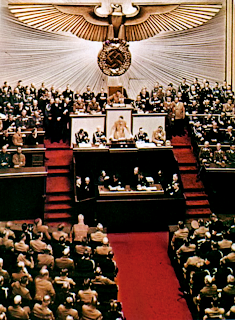







































+-+Explaining+Hitler+-+Occult+Third+Reich+-+Peter+Crawford.jpg)
















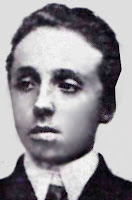
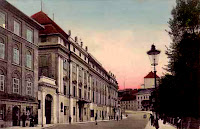



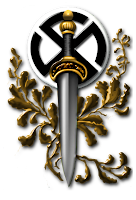


.png)



